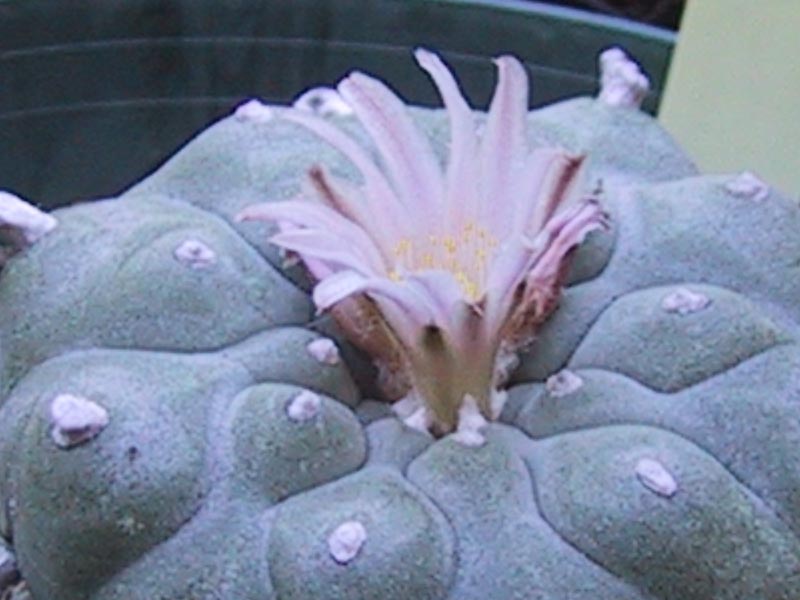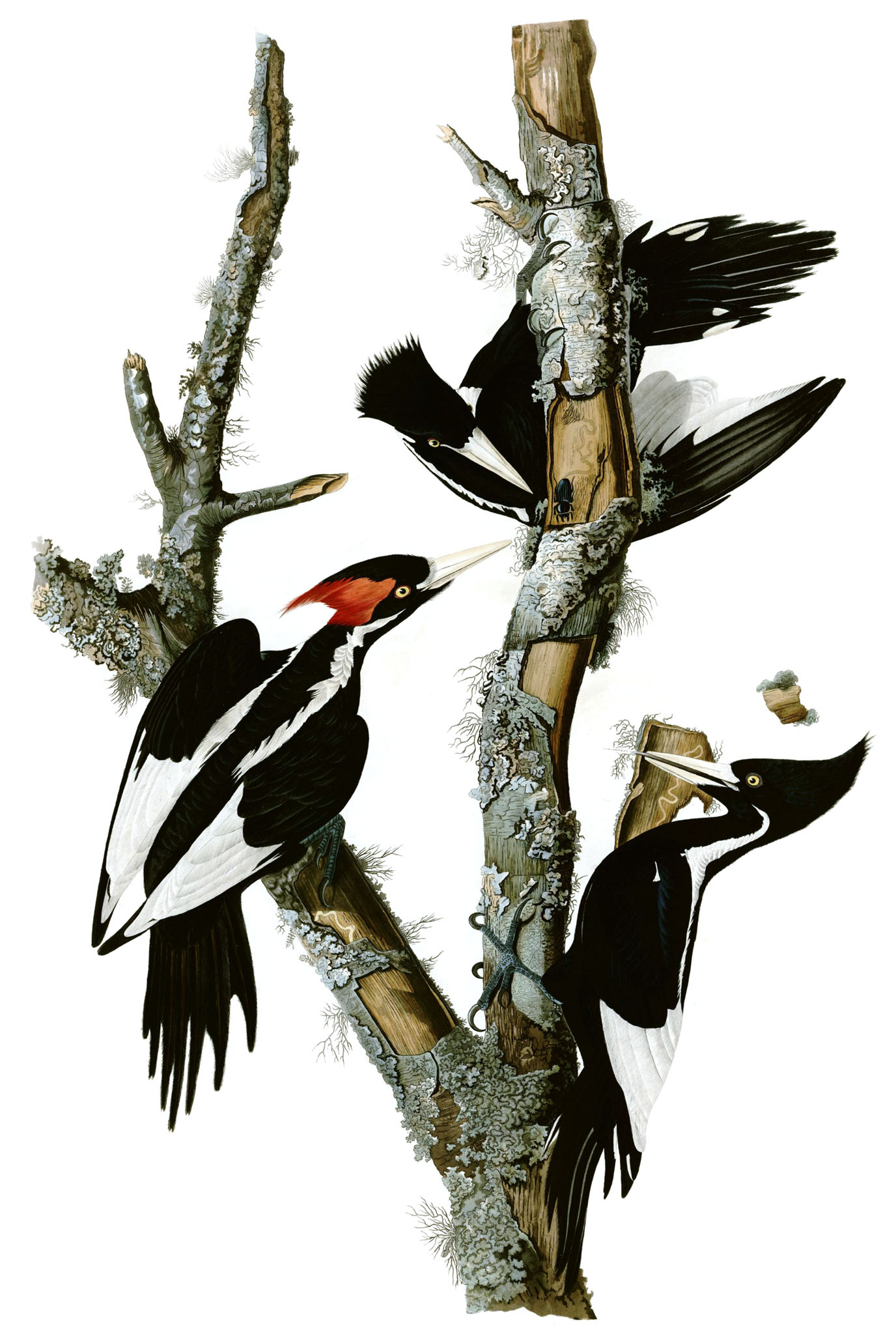
Peyote, Lophophora williamsii, May 2005
“The world around us is a mystery,” he said. “And men are no better than anything else. If a little plant is generous with us we must thank her, or perhaps she will not let us go.”
Journey to Ixtlan: The Lessons of Don Juan
This seems to have been the month when things, once seeming dead, suddenly came back to life.
A shriveled, crocodilian, door knob-shaped object sits in a flowerpot on my windowsill. Slightly larger than a golf ball, a few warty tubercules are scattered over its gray-green surface, each ending in a drooping little tuft of white hair. Most of the year, it just sits there, inscrutable, unchanging and to all intents and purposes, ‘dead.’ But once a year, sometime in May, if the sun has come through the window in just the right way, a small purplish-white flower emerges from its centre. In less than two days, the flower withers and falls off. It’s an easy thing to miss, but this ephemeral little flower is the only obvious external manifestation of the biochemical magic that seethes through the body of the peyotl, peyote or “tufted thing,” a plant so powerful that it is revered as a living god. When eaten, the peyote acts as a “revealer,” bending time and space into a crystalline continuum of an infinite now.
The peyote can take up to 30 years until it is ready to bloom, although this can be speeded up under cultivation. I don’t exactly know how old “mine” is. I hesitate to say “mine” because the concept of ownership doesn’t seem to apply to an entity that holds within it the pharmacological keys to the universe and which could, conceivably outlive me. In any case, I got the plant while I was a member of the local Desert Plant Society, over ten years ago, at a cactus swap meet. Its growth since then has been almost imperceptible. It seems to be waiting to tell me something. Maybe I’m not ready to hear it yet. . .
Perhaps the peyote would tell me that the secret to the universe is patience.
Does it require patience to be in a coma?
The BBC recounts the case of a fireman Donald Herbert, who, comatose since 1995, suddenly started to talk. His first sentence:
“I want to talk to my wife,”
The article continues with 56-year-old Jule Bridgewater’s reminiscence of being in a three-and-a-half week coma, an account uncannily like that of a peyote trip:
“During that time, something occurred that I had a sense of, it’s a sort of lost time-and-space thing,” she says. “It’s not like I was very aware of what I was doing, as I am now.”
“I was looking at myself from a great height, observing myself but not necessarily knowing that was myself or my unconscious or subconscious. I can’t define it as conscious intelligence.”
Are we waking up in a different world when we enter a coma or hallucination, just as we appear outwardly, to be retreating from this one?
In his brilliant (1971) The Futurological Congress, Stanislaw Lem explores the liminal between such cognitive states. He imagines how governments might one day be tempted to create a kind of “cryptochemocracy” in which public perception of an increasingly unpleasant reality would be managed using psycho-tropic substances, “Benignimizers,” added to the water supply. In this world, the most seditious act, punishable by death, is to take reality-inducing drugs, “vigilanimides,” to counteract the ubiquitous collective hallucination that everyone else inhabits. As the dosage of anti-hallucinogen is increased, the revealed reality becomes grimmer and grimmer. I’ll let the protagonist, Ijon Tichy, describe the experience:
“My hands were trembling as I pulled the cork and lifted the flask to my nostrils. A whiff of bitter almonds made my eyes well up with tears, and when I wiped them away, and could see again, I gasped. The magnificent hall, covered with carpets, filled with palms, the ornamented majolica walls, the elegance of the sparkling tables, and the orchestra in the back that played the exquisite chamber music while we dined, all this had vanished.”
“We were sitting in a concrete bunker, at a rough wooden table, a straw mat—badly frayed—beneath our feet. The music was still there, but I saw now that it came from a loudspeaker hung on a rusted wire. And the rainbow-crystal chandelier was now a dusty, naked light bulb. But the worst change had taken place before us on the table. The snow-white cloth was gone; the silver dish with the steaming pheasant had turned into a chipped earthenware plate containing the most unappetizing grey-brown gruel, which stuck in globs to my tin—no longer silver—fork.”
“I looked with horror upon the abomination that only moments ago I’d been consuming with such gusto, savouring the crackling golden skin of the bird and crunching—in sweet, succulent counterpoint—the croutons, crisp on the top and soaked with gravy on the bottom. And what I had taken for the overhanging leaves of a nearby potted palm turned out to be the drawstrings on the drawers of the person sitting (with three others) right above us—not on a balcony or platform, but rather a shelf, it was so narrow. For the place was packed beyond belief! My eyes were practically popping from their sockets when this terrifying vision wavered and began to shift back, as if touched with a magic wand.”
And what of those two, old Japanese soldiers, who have spent the last 60 years hiding in the jungles of Mindanao in the Philippines, left behind inside the hallucination of a long-finished war? To the rest of the world it was as if they had come back from the dead, but wait—did they really exist? It seems that the pair had become wary of the rapid influx of media into the area and have slipped back into their parallel universe. Who can blame them? They took a peek outside their own world and didn’t like what they saw. Maybe they are comfortable living inside their extended World War II hallucination. It seems somehow cruel to wrench them away from it.
In a strange twist of fate, both the ivory-billed woodpecker and W. Mark Felt, the man known from the Watergate era as Deep Throat, recently emerged from deep inside the collective American unconscious and out into the cold light of day. I am old enough (barely) to remember the zeal with which many people followed the televised Watergate hearings of the early 1970’s, tracking the cast of characters with the relentlessness of bird-watchers closing in on an endangered species. Interestingly, both the woodpecker and Deep Throat’s identity were unveiled within the very contemporary constraints of brand management and confidentiality agreements.
The Guardian reports on the strict code of secrecy maintained by Vanity Fair’s editors, while they were fact-checking Mr. Felt’s story, prior to his exclusive “outing” as Deep Throat in their magazine. This was made all the more difficult because they were loathe to consult Washington Post reporter Bob Woodward, Deep Throat’s original contact during Watergate, who upon learning that Felt was ready to reveal himself, might have bolted off to preemptively release his own story.
While an obsession with information management might have been the understandable legacy of Watergate, it is less understandable in the world of ornithology. The ivory-billed woodpecker, thought to have been extinct since about 1944, has been a kind of holy grail among birder-watchers whose hopes of adding it to their life lists have long been buoyed by repeated rumours of its sighting. Nicknamed the “Lord God bird, ” because of its size and spectacular plumage, this large woodpecker fell victim to the liquidation, in the 19th century, of the once vast riparian cypress forests of the American Southeast. It became, along with the passenger pigeon, a kind of poster species for America’s fall from grace with its wilderness. When credible reports of ivory-billed woodpecker sightings started emerging from the Big Woods region of Alabama, the Cornell Laboratory of Ornithology sent a team headed by Tim Gallagher accompanied by the Secretary of the Interior, Gale Norton, whom the Sierra Club points out is a former lobbyist for the logging and mining industries and an advocate of opening the Arctic National Wildlife Refuge up to oil drilling. The Christian Science Monitor reports that Gallagher and bird-watcher Bobby Harrison spotted an ivory-bill, before they could get their cameras in focus. All members of the research team were then asked to sign a confidentiality agreement until further corroboration of the bird’s existence could be achieved. A couple of months later on April 25, Dr. David Luneau of the University of Arkansas, shot about four seconds of blurry video from his kayak, wherein what purports to be an ivory-billed woodpecker, can be seen flying through a few of the frames. Ironically, according to the Monitor, the bird was flushed from the vicinity of a freeway overpass. Shortly thereafter, Luneau posted the enchanting little video clip directly to his website. Sadly, the clip can no longer be found there and it now exists only in a version book-ended inside a video press release, branded by the Nature Conservancy and the Cornell Lab of Ornithology. While the organizations in question are no doubt doing important work in the field of avian conservation, it seems a pity that we can no longer be trusted to view the un-packaged, un-enhanced, un-spun footage of the striking black and white bird, simply ghosting its way across the dun background of a flooded forest—a Lazarus species, flying out of the past and across our own time, magically, and for its own sake.
Bernard Henri Levy in the first of his series of articles in The Atlantic, entitled America in Foreign Eyes, sums up America’s bizarrely inauthentic relationship to the objects of its past:
What is at stake . . . is a relationship to time, and in particular to the past—as if, with this nation so eminently oriented toward its present and, especially, its future, regret for the past occurs only on condition that the past can be re-appropriated with well-calculated words and deeds. As if with all one’s strength—including the strength and power of myth and forgery—one has to reassert the power of the present over the past. Or the opposite, which comes down to the same thing: as if the pain was having not enough past rather than too much.



